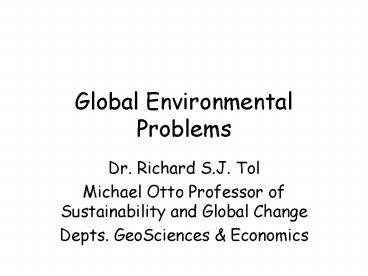Global Environmental Problems - PowerPoint PPT Presentation
1 / 17
Title:
Global Environmental Problems
Description:
The economics of the global environment ... 6.7 Holiday. 13.7 Trade and the environment. 20.6 Biodiversity. 27.6 Eutrophication. 4.7 Linkages ... – PowerPoint PPT presentation
Number of Views:342
Avg rating:3.0/5.0
Title: Global Environmental Problems
1
Global Environmental Problems
- Dr. Richard S.J. Tol
- Michael Otto Professor of Sustainability and
Global Change - Depts. GeoSciences Economics
2
Contact
- Room 008, Pavillion (behind Geomatikum)
Bundesstrasse 55, 20146 Hamburg - Tel 040 42838 7007/8
- Fax 040 42838 7009
- Email tol_at_dkrz.de
- http//www.uni-hamburg.de/Wiss/FB/15/Sustainabilit
y - The sheets are there, as well as old exams
3
Global Environmental Problems, lecture 1
- Course aims and set-up
- Externalities
- International externalities
- Game theory
4
The Course
- The economics of the global environment
- Prior knowledge micro, macro, calculus,
environmental and resource economics - Reader
- Other courses Wahlpflichtfach Umweltökonomie
Environmental and Resource Economics (WS),
Valuation (SS, odd years), Agricultural Economics
(WS), Seminar (every semester)
5
The Lectures
- 11.4 Introduction
- 18.4 Acidification
- 25.4 Ozone layer
- 2.5 Climate change impacts
- 9.5 Climate change emission reduction
- 16.5 Climate change optimal control
- 23.5 Climate change cooperation
- 30.5 Climate change policy instruments
- 6.7 Holiday
- 13.7 Trade and the environment
- 20.6 Biodiversity
- 27.6 Eutrophication
- 4.7 Linkages
6
The Exam
- My exams are really not that difficult (see
website) - However, a number of students show up unprepared,
and a number should not be studying (economics)
at all - Between 1/4 and 1/3 of candidates fail the exam
7
Externalities
- External effect is said to occur when the
production or consumption of one agent affects
the utility of another agent in an unintended
way, and when no compensation is made - External effect externality external cost
external diseconomy - External effect may be beneficial or adverse,
consumption or production related - If compensated, the externality is said to be
internalised
8
Externalities -2
- Typically, externalities are internalised by
government intervention, be it with - Information, persuasion and voluntary agreements
- Direct regulation
- Property rights
- Taxes and subsidies
- Tradeable permits
- This does not work for international
externalities!
9
International Externalities
- International externalities are the unintended
and uncompensated byproduct of one countrys
consumption or production on another countrys
welfare - Natural and environmental resources do not
respect administrative borders, so exploitation
of shared (water) and mobile (fish) resources as
well as persistent emissions (water, air) lead to
international externalities so do resources such
as biodiversity
10
International Pollution
- Consider n countries with emissions e. Reducing
emissions is costly, or emissions bring welfare
R. For each country j there is an environmental
variable z which depends on the emissions from
all countries. The higher z, the worse the
environment, and the lower welfare D. Let us
consider flow pollutants only. Assume that
countries may transfer money I to each other.
11
International Pollution -2
- Assume that environmental pollution z is a linear
function of emissions e. - In some cases, pollution is uniform
- In other cases, not
12
Non-Cooperative Solution
- That is, for all countries, optimal emissions are
such that the marginal benefits of emitting equal
the marginal costs to the country itself
13
Cooperative Solution
- That is, for all countries, optimal emissions are
such that the (weighted) marginal benefits of
emitting equal sum of the (weighted) marginal
costs to all countries
14
Non-Cooperative with Tax
- There is a tax that restores the social optimum
this is the Pigou tax it is different for all
parties - There is no international tax authority
15
Cooperation with Transfers
That is, effective welfare weights
reflect economic power
16
Insights
- A non-cooperative solution ignores externalities,
and is therefore not optimal - A cooperative solution is in the best interest of
all together, although not necessarily in the
interest of each individual - Under some conditions, a cooperative solution
generates enough surplus to compensate the losers
of cooperation but it is the losers of
pollution that pay - With transfers, it is the rich that have most
influence on the result
17
This course will ...
- Discuss a number of global environmental issues
- Treat the theory in the context of a series of
concrete problems - Focus on climate change































